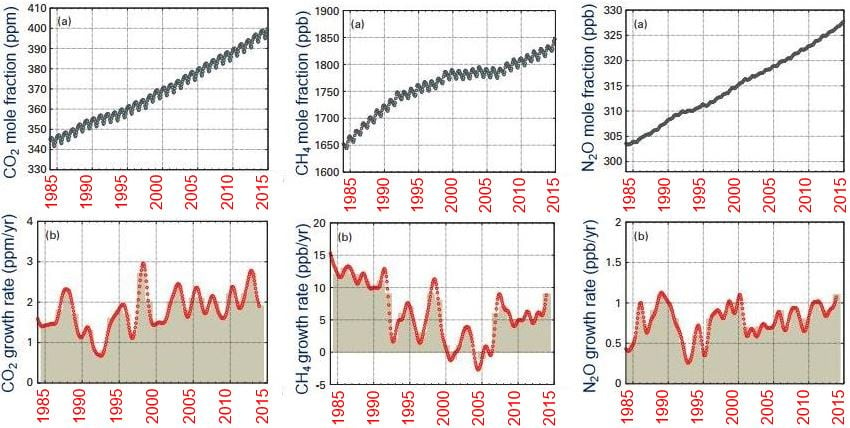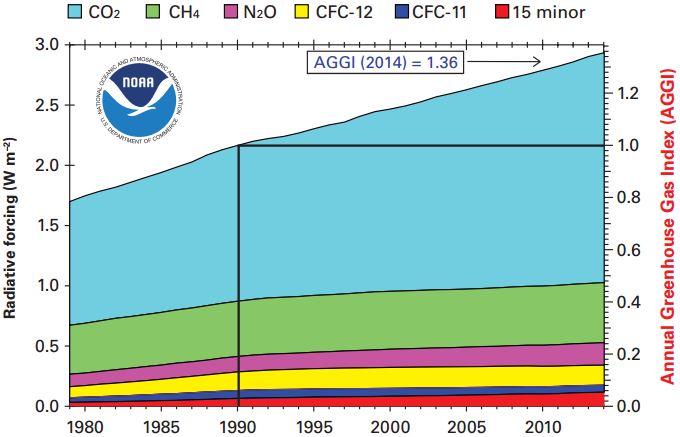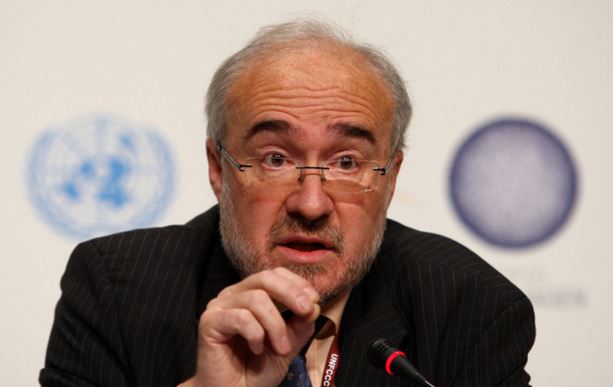Global CO2 levels were 143% higher in 2014 than they were before the industrial revolution, says the World Meteorological Organization (WMO), the specialized agency of the United Nations for meteorology. The relentless rise, which is driving climate change, will make our planet much more dangerous and inhospitable for generations to come, the WMO warns.
According to the World Meteorological Organization’s Greenhouse Gas Bulletin, between 1990 and 2014 a 36% increase in radiative forcing was registered. Radiation forcing refers to the warming effect on our climate. This has been due to long-lived greenhouse gases such as CH4 (methane), CO2 (carbon dioxide) and N2O (nitrous oxide) from agricultural, industrial and domestic activities.
The report authors also highlight the interaction and amplication effect between higher CO2 levels and water vapor, which is also a major greenhouse gas, albeit short-lived.
 Globally averaged CO2, CH4 and N2O mole fraction and their growth rates from 1984 to 2014. (Source: WMOs Greenhouse Gas Bulletin)
Globally averaged CO2, CH4 and N2O mole fraction and their growth rates from 1984 to 2014. (Source: WMOs Greenhouse Gas Bulletin)
Water vapor exacerbates the greenhouse effect
When the air is warmer it can hold more moisture, so higher surface temperatures caused by carbon dioxide would lead to greater global water vapor levels, further exacerbating the enhanced greenhouse effect.
As CO2 concentrations rise further, there will be disproportionately greater increases in thermal energy and warming from water vapor.
WMO Secretary-General Michel Jarraud, said:
“Every year we report a new record in greenhouse gas concentrations. Every year we say that time is running out. We have to act NOW to slash greenhouse gas emissions if we are to have a chance to keep the increase in temperatures to manageable levels.”
In 2014, atmospheric levels of CO2 reached 397.7 ppm (parts per million). Carbon dioxide is the most important long-lived greenhouse gas.
In the spring of 2014, the season when CO2 is more abundant in the northern hemisphere, levels exceeded the symbolically significant 440 ppm level. By spring this year, the global average CO2 concentration exceeded the 400 ppm barrier.
 Atmospheric radiative forcing, relative to 1750, of long-lived greenhouse gases and the 2014 update of the NOAA Annual Greenhouse Gas Index. (Source: WMOs Greenhouse Gas Bulletin)
Atmospheric radiative forcing, relative to 1750, of long-lived greenhouse gases and the 2014 update of the NOAA Annual Greenhouse Gas Index. (Source: WMOs Greenhouse Gas Bulletin)
CO2 – the invisible but real threat
Mr. Jarraud said:
“We will soon be living with globally averaged CO2 levels above 400 parts per million as a permanent reality. We can’t see CO2. It is an invisible threat, but a very real one.”
“It means hotter global temperatures, more extreme weather events like heatwaves and floods, melting ice, rising sea levels and increased acidity of the oceans. This is happening now and we are moving into unchartered territory at a frightening speed.”
 Michel Jarraud has been the Secretary-General of the World Meteorological Organization since 2004.
Michel Jarraud has been the Secretary-General of the World Meteorological Organization since 2004.
“Excess energy trapped by CO2 and other greenhouse gases is heating up the Earth surface which leads to increase in atmospheric water vapour which in turn is generating/trapping even more heat.”
“Carbon dioxide remains in the atmosphere for hundreds of years and in the ocean for even longer. Past, present and future emissions will have a cumulative impact on both global warming and ocean acidification. The laws of physics are non-negotiable.”
The WMO Greenhouse Gas Bulletin only has data on atmospheric concentrations of greenhouse gases, and not emissions. Emissions refer to what goes into the atmosphere, while concentrations refer to what there is in the atmosphere after the complex system of interactions between the atmosphere, cryosphere (frozen water of the Earth’s system), biosphere (Earth’s surface and atmosphere) and the oceans.
Approximately 25% of all emissions are taken up by the oceans, and the same amount by the biosphere, thus reducing the amount of carbon dioxide in the atmosphere.
The Greenhouse Gas Bulletin’s data provide a scientific base for decision-making. The Bulletin has been released ahead of the United Nations climate change negotiations, which will be held this year in Paris from November 30th to December 11th.
A separate report – Emissions Gap – from the US Environment Program, focuses on annual CO2 emissions.
Atmospheric concentrations of greenhouse gases
Carbon Dioxide: accounted for approximately 83% of the total radiative forcing increased by long-lived greenhouse gases over the last ten years.
At a level of about 278 ppm before the industrial revolution, there was a balance between the atmosphere, the biosphere and the oceans.
Human activities, including the burning of fossil fuels has shifted the natural balance. In 2014, average CO2 levels were 143% of pre-industrial levels.
Last year, global annual average CO2 concentrations reached 397.7 ppm, with last year’s increase close to the 10-year average. By 2016, the global average will probably exceed 400 ppm.
Methane: this is the second most important long-lived greenhouse gas. Natural sources account for about 40% of the methane that is emitted into our atmosphere, while approximately 60% comes from human activities like rice agriculture, fossil fuel exploitation, landfills, biomass burning, and cattle breeding.
Levels of atmospheric methane reached 1,833 ppb (parts per billion) in 2014 – a new high. Today it is at 254% of the pre-industrial level.
Nitrous oxide: N2O is partly emitted into the atmosphere from natural sources (60%), and the rest from human activities (40%). The nitrous oxide concentration level in 2014 was approximately 327.1 ppb.
Concentrations levels of N2O today are at 121% of pre-industrial levels.
Water Vapour: CO2 and water vapor are the two main greenhouse gases. However, the main driver of climate change is carbon dioxide. Water vapor changes occur as a response to changing levels of CO2.
The authors of the Bulletin wrote “For a scenario considering doubling of is CO2 concentration from pre-industrial conditions, i.e. from about 280 to 560 ppm, water vapour and clouds globally would lead to an increase in atmospheric warming that is about three times that of long-lived greenhouse gases.”
